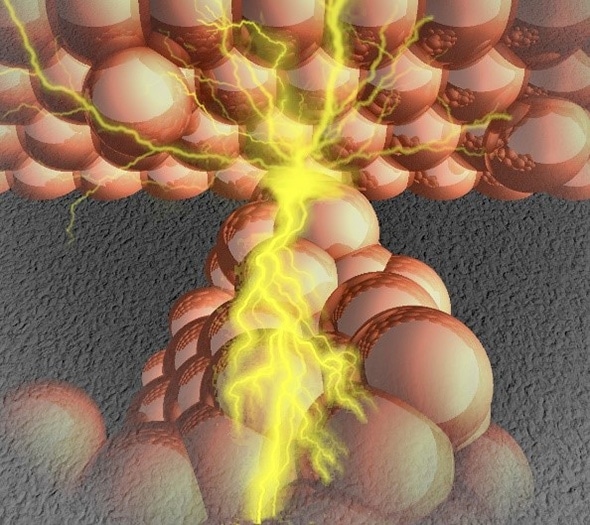Jul 22 2019
Scientists from Tokyo Tech have been able to gather unparalleled insights into the inner workings of an atomic switch. By exploring the composition of the miniature metal “bridge” that forms within the switch, the study outcomes may stimulate the design of atomic switches with better performance.
 Conceptual image of a metallic filament inside an atomic switch. The “bridge” that forms within the metal sulfide layer, connecting two metal electrodes, results in the atomic switch being turned on. (Image credit: Manabu Kiguchi)
Conceptual image of a metallic filament inside an atomic switch. The “bridge” that forms within the metal sulfide layer, connecting two metal electrodes, results in the atomic switch being turned on. (Image credit: Manabu Kiguchi)
Atomic switches are praised as the smallest of electrochemical switches with the potential to transform information technology. Owing to their nanoscale dimensions and minimal power consumption, they exhibit the potential for incorporation into next-generation circuits that could stimulate the progress of artificial intelligence (AI) and Internet of Things (IoT) devices.
Although many designs have materialized, one intriguing query concerns the kind of the metallic filament (or bridge) that is vital to the working of the switch. The bridge forms within a metal sulfide layer inserted between two electrodes and is regulated by applying a voltage that triggers an electrochemical reaction. The formation and annihilation of this bridge establish whether the switch is on or off.
Presently, a research team comprising Akira Aiba, Manabu Kiguchi, and colleagues at the Tokyo Institute of Technology’s Department of Chemistry has discovered a practical way to investigate exactly what the bridge is made up of.
By cooling the atomic switch sufficiently in order to be able to investigate the bridge using a low-temperature measurement method known as point contact spectroscopy (PCS), their research exposed that the bridge is composed of metal atoms from the electrode as well as the metal sulfide layer. This unexpected finding refutes the prevailing belief that the bridge originates from the electrode only, Kiguchi states.
The researchers compared atomic switches with various combinations of electrodes (Ag and Pt, or Pt and Cu) and metal sulfide layers (Cu2S and Ag2S). In the two cases, they learned that the bridge is mostly made up of Ag.
Ag dominance in the bridge is probably because of “the higher mobility of Ag ions compared to Cu ions,” the scientists explain in their paper published in ACS Applied Materials & Interfaces.
“It would be better to use metals with low mobility” for developing atomic switches with higher stability, concluded the researchers.
A lot needs to be still investigated in the development of atomic switch technologies, and the research team is continuing to explore which grouping of elements would be the most ideal in enhancing performance.